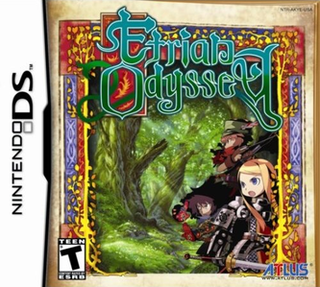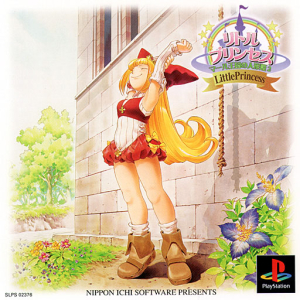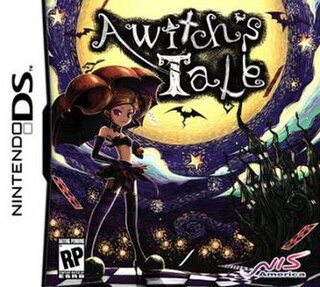
Atlus Co., Ltd. is a Japanese video game developer, publisher, arcade manufacturer and distribution company based in Tokyo. A subsidiary of Sega, the company is known for video game series such as Megami Tensei, Persona, Etrian Odyssey, and Trauma Center, as well as Print Club (Purikura) arcade machines. Its corporate mascot is Jack Frost, a snowman-like character from their Shin Megami Tensei series. Outside of video games, the company is known for their Purikura arcade machines, which are selfie photo sticker booths popular in East Asia.

Disgaea: Hour of Darkness is a tactical role-playing video game developed and published by Nippon Ichi Software for the Sony PlayStation 2 video game console. Set in a world full of demons and angels, the story follows Laharl, the son of a demon overlord, who upon being awakened after a two-year slumber, aspires to succeed his father’s place while also fighting rival demons in the process.

Nippon Ichi Software, Inc. is a Japanese video game developer and publisher. The company was founded in 1991 and has developed several role-playing video games, most notably the Disgaea and Marl Kingdom series. Its mascot is the penguin-like Disgaea character Prinny.
Tactical role-playing games, also known as strategy role-playing games and in Japan as simulation RPGs, are a video game genre that combines core elements of role-playing video games with those of tactical strategy video games. The formats of tactical RPGs are much like traditional tabletop role-playing games and strategy games in appearance, pacing, and rule structure. Likewise, early tabletop role-playing games are descended from skirmish wargames such as Chainmail, which were primarily concerned with combat.

Tenpei Sato is a video game composer and voice actor. His most notable works are his soundtracks for Nippon Ichi Software games, such as Disgaea and Phantom Brave. He also provides voice-over for games and movies.

Contact is a role-playing video game developed by Grasshopper Manufacture for the Nintendo DS handheld game console. It was published by Marvelous Entertainment in Japan on March 30, 2006, by Atlus USA in North America on October 18, and by Rising Star Games in Australia, Asia and Europe on January 25, 2007 and February 2, respectively.

Persona 3, released outside Japan as Shin Megami Tensei: Persona 3, is a 2006 role-playing video game developed by Atlus that is the fourth main installment in the Persona series, which is part of the larger Megami Tensei franchise. It was originally released for the PlayStation 2 in Japan in 2006 and in North America in 2007. It has received several enhanced re-releases and ports: Persona 3 FES, an extended version featuring a new playable epilogue and other changes, was released for the PlayStation 2 in Japan in 2007 and worldwide in 2008. An abridged PlayStation Portable version, Persona 3 Portable, was released in Japan in 2009, North America in 2010, and Europe in 2011, and ported to the Nintendo Switch, PlayStation 4, Windows, Xbox One, and Xbox Series X/S in 2023. Persona 3 Reload, a remake of the core game for PlayStation 4, PlayStation 5, Windows, Xbox One, and Xbox Series X/S, was released on February 2, 2024.

Summon Night is a series of role-playing video games, mixed with elements of a visual novel based dating sim. The series is primarily developed by Flight-Plan, published by Banpresto, and owned by Bandai Namco Entertainment. The character designs are by Izuka Takeshi. The series has had six main line entries, and seven spin-off entries, spanning the PlayStation, PlayStation 2, PlayStation 4, PlayStation Portable, PlayStation Vita, Game Boy Advance and Nintendo DS video game consoles.

Etrian Odyssey is a 2007 3D dungeon crawler role-playing video game by Atlus for the Nintendo DS. It centers around first-person exploration of a mysterious dungeon known as the Yggdrasil Labyrinth using a player-created party of characters. The game received mixed to positive reviews from critics, who criticized its punishing difficulty as limiting its appeal, but also making its gameplay more rewarding.

Luminous Arc is a tactical role-playing game developed by Imageepoch for the Nintendo DS, and the first in the Luminous Arc series. The game was released on February 8, 2007 in Japan, August 14, 2007 in North America, and October 18, 2007 in Australia by Atlus, and in Europe the following day by Rising Star Games.

Rhapsody II: Ballad of the Little Princess is a role-playing video game developed and published by Nippon Ichi Software for the original PlayStation and is the second installment in the Rhapsody series. The game takes place twelve years after the event of its predecessor, Rhapsody: A Musical Adventure, and features much of the same characters. Like its predecessor, Little Princess includes many musical interludes and focuses on the themes of falling in love and fulfilling your dreams, though the tactical role-playing game battle system of Rhapsody was discarded for a more traditional RPG battle system.

Rhapsody III: Memories of Marl Kingdom is a role-playing video game developed and published by Nippon Ichi Software for the PlayStation 2. It is the third installment in the Rhapsody series. Unlike the previous games in the series, this game was only released once, although a special limited edition version of the game was released concurrently.
Rhapsody is a series of RPGs developed by Nippon Ichi Software. The three main games in the series are Rhapsody: A Musical Adventure, Rhapsody II: Ballad of the Little Princess, and Rhapsody III: Memories of Marl Kingdom.

A Witch's Tale is a 2009 video game for the Nintendo DS. It was developed by Hit Maker and published by Nippon Ichi Software.

Disgaea is a series of tactical role-playing video games created and developed by Nippon Ichi. The series debuted in Japan on January 30, 2003, with Disgaea: Hour of Darkness, later re-released as Disgaea: Afternoon of Darkness and Disgaea DS. One of Nippon Ichi's most popular franchises, it has branched off into both a manga and anime series. The Disgaea games are known for complex gameplay, extremely high maximum stats and humorous dialogue. The Disgaea series has shipped 5 million copies as of 2021.

Shin Megami Tensei: Strange Journey is a role-playing video game developed by Atlus and Lancarse for the Nintendo DS. The game is the sixth entry in the Shin Megami Tensei series, which forms the core of the Megami Tensei franchise. It was released in Japan in 2009, and in North America in 2010. An enhanced port for the Nintendo 3DS, Shin Megami Tensei: Strange Journey Redux, was released in Japan in 2017, and was released internationally in 2018 by Atlus in North America and Deep Silver in Europe.

Radiant Historia is a role-playing video game co-developed by Atlus and Headlock for the Nintendo DS. It was released in Japan in 2010 by Atlus, and in North America in 2011 by their subsidiary Atlus USA. An expanded remake for the Nintendo 3DS, titled Radiant Historia: Perfect Chronology, was released in 2017 in Japan and released in North America and Europe the following year, with the European version being published by Deep Silver.
Ningyo-hime, which can mean both "Mermaid Princess" (人魚姫) or "Puppet Princess" (人形姫), may refer to:

Labyrinth of Refrain: Coven of Dusk is a dungeon crawler role playing video game developed and published by Nippon Ichi Software. It was released in Japan in June 2016 for the PlayStation Vita and in September 2017 for the PlayStation 4. The game was then released internationally on PlayStation 4, Nintendo Switch, and Microsoft Windows in September 2018. It was followed by Labyrinth of Galleria: The Moon Society.

















